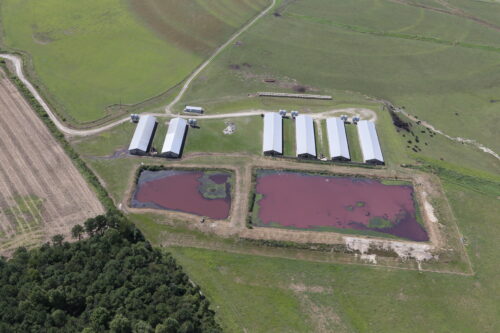Image courtesy of Flickr.
Concentrated animal feeding operations (CAFOs), or intensive animal production facilities, minimize the space necessary to produce the greatest number of livestock possible. These facilities also produce high concentrations of waste and pollution, which pose significant environmental threats to local water systems and air quality, and they have been linked to increased respiratory dysfunction, lower immune health, and lower mental health for workers and for the people of nearby populations. According to a recent study by Ji-Young Son, associate research scientist, and Michelle Bell, professor of environmental health at Yale’s School of the Environment, CAFOs are disproportionately distributed near communities of color and impoverished communities. The Bell Research Group hopes to address this environmental injustice in collaboration with Arizona State University and Rice University by developing more accurate models of CAFO exposure to inform communities and policymakers.
The researchers studied North Carolina, home to the second largest hog industry in the US, and estimated CAFO exposure across the state. Consistent with results of previous studies, they found a high density of CAFOs close to racial/ethnic minority communities and areas of poverty. However, their model—an advancement of previous work—showed larger areas of risk compared to more traditional methods.
“Our study suggested that more refined exposure assessment from CAFOs is very important,” said Son, lead author and a member of the Bell Research Group. Previous studies analyzed CAFO exposure by counting the CAFO facilities within a given area—such as within each ZIP code of a state—or by assessing the distance of different populations to nearby CAFOs. The Bell Research Group developed a more advanced approach that addresses several limitations of earlier work. In their approach, exposure to CAFOs accounted for proximity of a community to multiple CAFO facilities. Their data was able to show that a CAFO near a ZIP code boundary impacts more than one ZIP code region.
The researchers also analyzed the racial residential isolation and the educational residential isolation of North Carolina in relation to CAFOs. The researchers used these more complex metrics to evaluate the segregation of communities by race and education level, instead of simply measuring the percentages of different demographic groups within a community.
According to Son, determining the relative segregation of different populations is crucial for understanding the environmental justice implications of CAFO pollution. The disparities in CAFO exposure were starker under the team’s newly developed exposure approach compared to earlier more simplistic methods, which suggests that the earlier work underestimated the environmental justice issue of CAFOs.
The Bell Research Group hopes to expand their study to include other regions of the country and metrics that will account for CAFO size and intensity. “CAFO-produced pollution may have a substantial impact on health,” Son said. “Our next step is to look at associated health disparities in nearby communities, especially in communities of minorities and low socioeconomic status.”
Son, J. Y., Muenich, R. L., Schaffer-Smith, D., Miranda, M. L., & Bell, M. L. (2021). Distribution of environmental justice metrics for exposure to CAFOs in North Carolina, USA. Environmental Research, 195, 110862.

